RCC Coursework: Quantitative and Qualitative Analysis Report
VerifiedAdded on 2023/01/12
|13
|4199
|96
Report
AI Summary
This report provides a comprehensive analysis of the Recycling Centre Corporation (RCC), encompassing both quantitative and qualitative aspects. The quantitative analysis focuses on the heavy-duty spreader, calculating its capacity, annual revenue, production costs, and profit, including a break-even analysis. The qualitative analysis identifies managerial challenges such as operational capacity management, financial analysis of costs and revenue, and strategic customer requirements. Furthermore, the report explores strategic directions for RCC using the Ansoff matrix, offering recommendations for appropriate managerial actions to improve business performance and address operational inefficiencies. The report aims to develop an understanding of qualitative and quantitative analysis concepts within a business context.
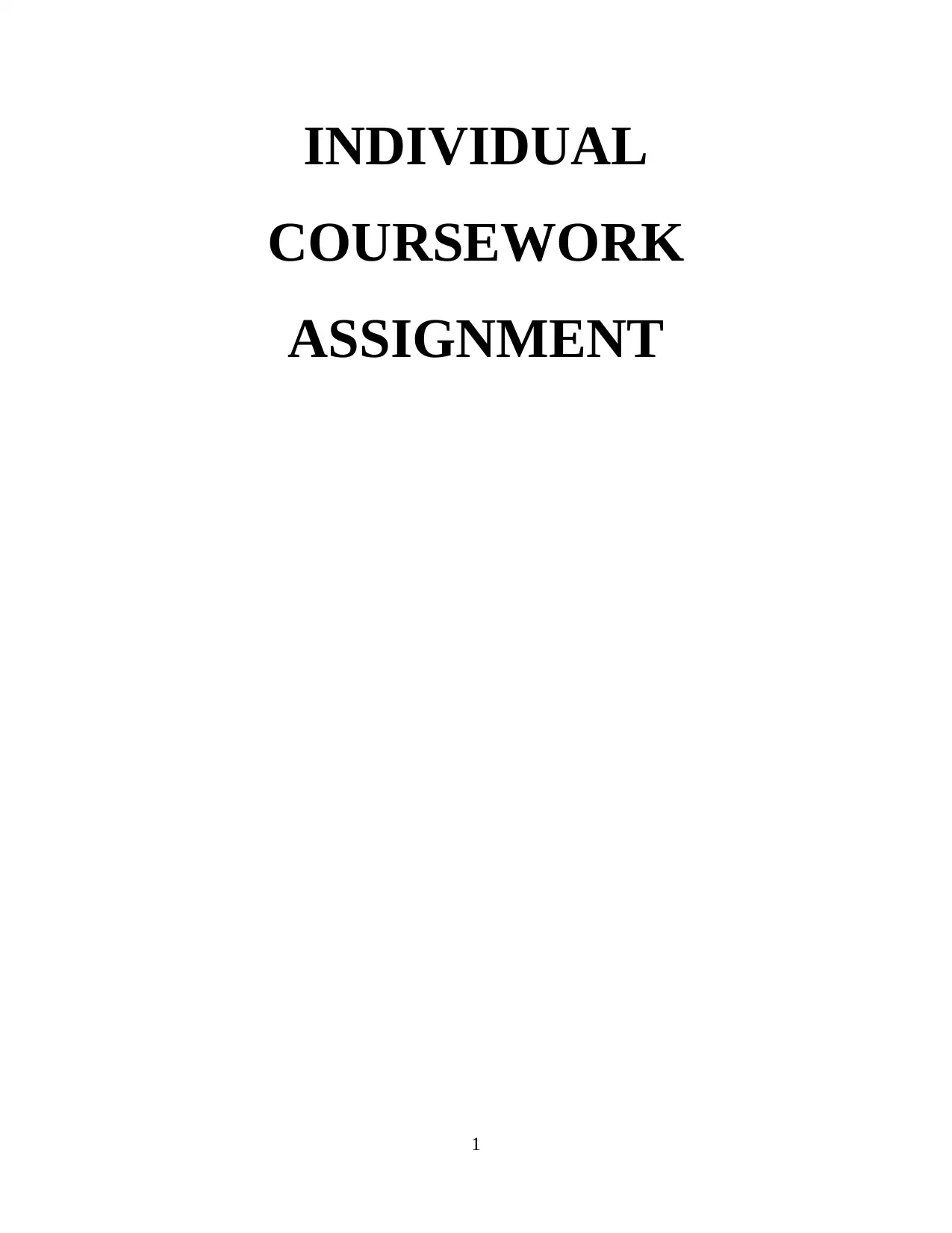
INDIVIDUAL
COURSEWORK
ASSIGNMENT
1
COURSEWORK
ASSIGNMENT
1
Paraphrase This Document
Need a fresh take? Get an instant paraphrase of this document with our AI Paraphraser
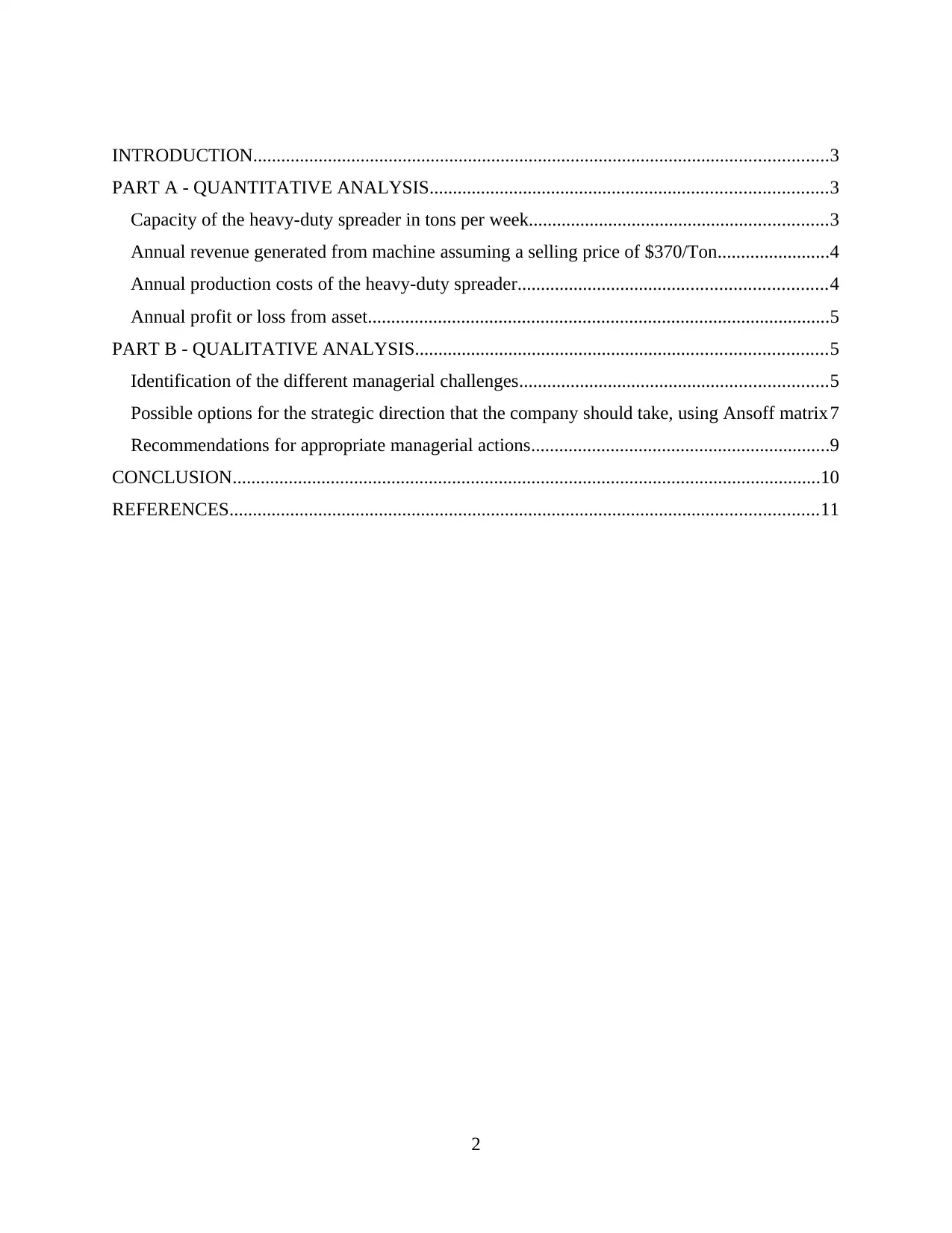
INTRODUCTION...........................................................................................................................3
PART A - QUANTITATIVE ANALYSIS.....................................................................................3
Capacity of the heavy-duty spreader in tons per week................................................................3
Annual revenue generated from machine assuming a selling price of $370/Ton........................4
Annual production costs of the heavy-duty spreader..................................................................4
Annual profit or loss from asset...................................................................................................5
PART B - QUALITATIVE ANALYSIS........................................................................................5
Identification of the different managerial challenges..................................................................5
Possible options for the strategic direction that the company should take, using Ansoff matrix 7
Recommendations for appropriate managerial actions................................................................9
CONCLUSION..............................................................................................................................10
REFERENCES..............................................................................................................................11
2
PART A - QUANTITATIVE ANALYSIS.....................................................................................3
Capacity of the heavy-duty spreader in tons per week................................................................3
Annual revenue generated from machine assuming a selling price of $370/Ton........................4
Annual production costs of the heavy-duty spreader..................................................................4
Annual profit or loss from asset...................................................................................................5
PART B - QUALITATIVE ANALYSIS........................................................................................5
Identification of the different managerial challenges..................................................................5
Possible options for the strategic direction that the company should take, using Ansoff matrix 7
Recommendations for appropriate managerial actions................................................................9
CONCLUSION..............................................................................................................................10
REFERENCES..............................................................................................................................11
2
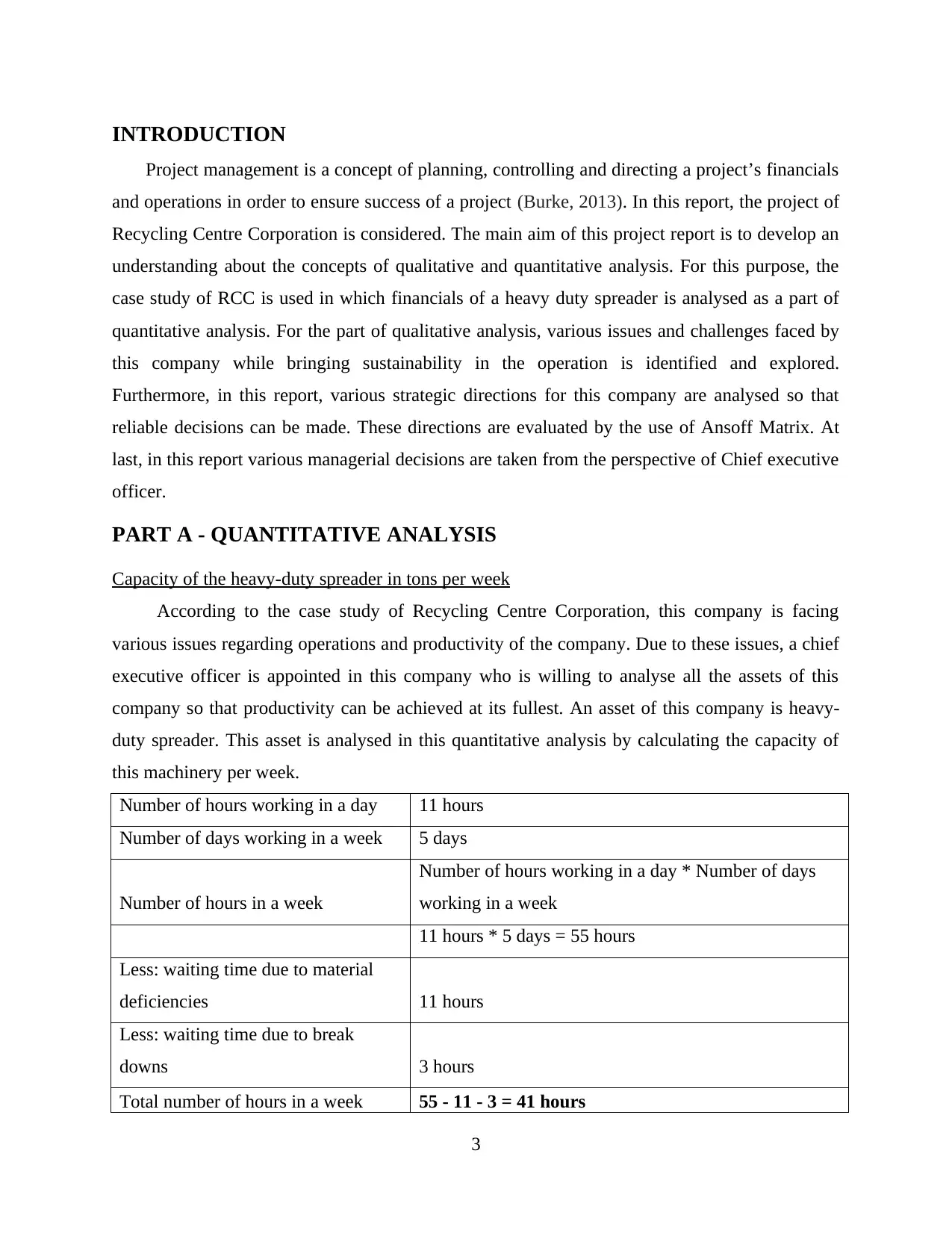
INTRODUCTION
Project management is a concept of planning, controlling and directing a project’s financials
and operations in order to ensure success of a project (Burke, 2013). In this report, the project of
Recycling Centre Corporation is considered. The main aim of this project report is to develop an
understanding about the concepts of qualitative and quantitative analysis. For this purpose, the
case study of RCC is used in which financials of a heavy duty spreader is analysed as a part of
quantitative analysis. For the part of qualitative analysis, various issues and challenges faced by
this company while bringing sustainability in the operation is identified and explored.
Furthermore, in this report, various strategic directions for this company are analysed so that
reliable decisions can be made. These directions are evaluated by the use of Ansoff Matrix. At
last, in this report various managerial decisions are taken from the perspective of Chief executive
officer.
PART A - QUANTITATIVE ANALYSIS
Capacity of the heavy-duty spreader in tons per week
According to the case study of Recycling Centre Corporation, this company is facing
various issues regarding operations and productivity of the company. Due to these issues, a chief
executive officer is appointed in this company who is willing to analyse all the assets of this
company so that productivity can be achieved at its fullest. An asset of this company is heavy-
duty spreader. This asset is analysed in this quantitative analysis by calculating the capacity of
this machinery per week.
Number of hours working in a day 11 hours
Number of days working in a week 5 days
Number of hours in a week
Number of hours working in a day * Number of days
working in a week
11 hours * 5 days = 55 hours
Less: waiting time due to material
deficiencies 11 hours
Less: waiting time due to break
downs 3 hours
Total number of hours in a week 55 - 11 - 3 = 41 hours
3
Project management is a concept of planning, controlling and directing a project’s financials
and operations in order to ensure success of a project (Burke, 2013). In this report, the project of
Recycling Centre Corporation is considered. The main aim of this project report is to develop an
understanding about the concepts of qualitative and quantitative analysis. For this purpose, the
case study of RCC is used in which financials of a heavy duty spreader is analysed as a part of
quantitative analysis. For the part of qualitative analysis, various issues and challenges faced by
this company while bringing sustainability in the operation is identified and explored.
Furthermore, in this report, various strategic directions for this company are analysed so that
reliable decisions can be made. These directions are evaluated by the use of Ansoff Matrix. At
last, in this report various managerial decisions are taken from the perspective of Chief executive
officer.
PART A - QUANTITATIVE ANALYSIS
Capacity of the heavy-duty spreader in tons per week
According to the case study of Recycling Centre Corporation, this company is facing
various issues regarding operations and productivity of the company. Due to these issues, a chief
executive officer is appointed in this company who is willing to analyse all the assets of this
company so that productivity can be achieved at its fullest. An asset of this company is heavy-
duty spreader. This asset is analysed in this quantitative analysis by calculating the capacity of
this machinery per week.
Number of hours working in a day 11 hours
Number of days working in a week 5 days
Number of hours in a week
Number of hours working in a day * Number of days
working in a week
11 hours * 5 days = 55 hours
Less: waiting time due to material
deficiencies 11 hours
Less: waiting time due to break
downs 3 hours
Total number of hours in a week 55 - 11 - 3 = 41 hours
3
⊘ This is a preview!⊘
Do you want full access?
Subscribe today to unlock all pages.

Trusted by 1+ million students worldwide
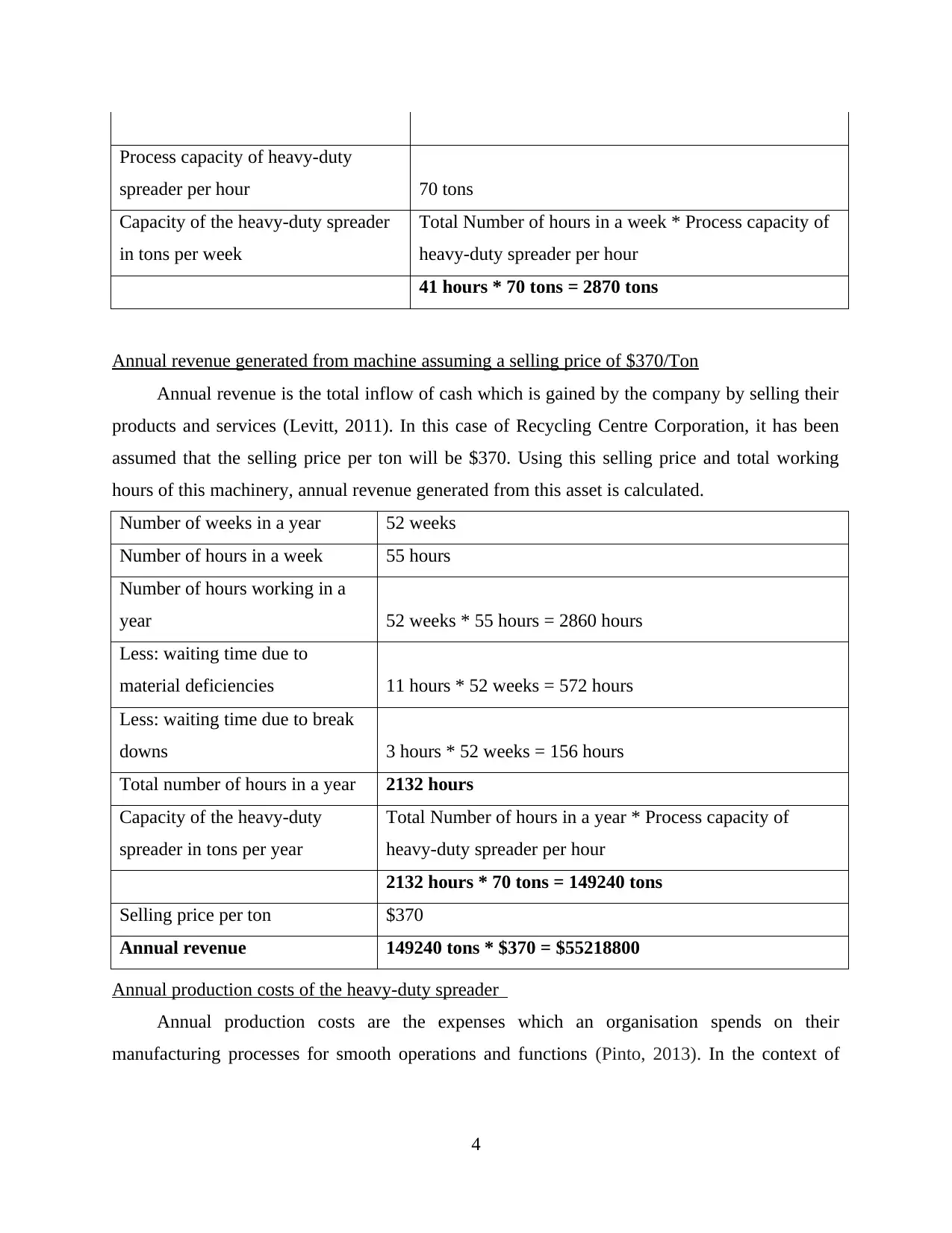
Process capacity of heavy-duty
spreader per hour 70 tons
Capacity of the heavy-duty spreader
in tons per week
Total Number of hours in a week * Process capacity of
heavy-duty spreader per hour
41 hours * 70 tons = 2870 tons
Annual revenue generated from machine assuming a selling price of $370/Ton
Annual revenue is the total inflow of cash which is gained by the company by selling their
products and services (Levitt, 2011). In this case of Recycling Centre Corporation, it has been
assumed that the selling price per ton will be $370. Using this selling price and total working
hours of this machinery, annual revenue generated from this asset is calculated.
Number of weeks in a year 52 weeks
Number of hours in a week 55 hours
Number of hours working in a
year 52 weeks * 55 hours = 2860 hours
Less: waiting time due to
material deficiencies 11 hours * 52 weeks = 572 hours
Less: waiting time due to break
downs 3 hours * 52 weeks = 156 hours
Total number of hours in a year 2132 hours
Capacity of the heavy-duty
spreader in tons per year
Total Number of hours in a year * Process capacity of
heavy-duty spreader per hour
2132 hours * 70 tons = 149240 tons
Selling price per ton $370
Annual revenue 149240 tons * $370 = $55218800
Annual production costs of the heavy-duty spreader
Annual production costs are the expenses which an organisation spends on their
manufacturing processes for smooth operations and functions (Pinto, 2013). In the context of
4
spreader per hour 70 tons
Capacity of the heavy-duty spreader
in tons per week
Total Number of hours in a week * Process capacity of
heavy-duty spreader per hour
41 hours * 70 tons = 2870 tons
Annual revenue generated from machine assuming a selling price of $370/Ton
Annual revenue is the total inflow of cash which is gained by the company by selling their
products and services (Levitt, 2011). In this case of Recycling Centre Corporation, it has been
assumed that the selling price per ton will be $370. Using this selling price and total working
hours of this machinery, annual revenue generated from this asset is calculated.
Number of weeks in a year 52 weeks
Number of hours in a week 55 hours
Number of hours working in a
year 52 weeks * 55 hours = 2860 hours
Less: waiting time due to
material deficiencies 11 hours * 52 weeks = 572 hours
Less: waiting time due to break
downs 3 hours * 52 weeks = 156 hours
Total number of hours in a year 2132 hours
Capacity of the heavy-duty
spreader in tons per year
Total Number of hours in a year * Process capacity of
heavy-duty spreader per hour
2132 hours * 70 tons = 149240 tons
Selling price per ton $370
Annual revenue 149240 tons * $370 = $55218800
Annual production costs of the heavy-duty spreader
Annual production costs are the expenses which an organisation spends on their
manufacturing processes for smooth operations and functions (Pinto, 2013). In the context of
4
Paraphrase This Document
Need a fresh take? Get an instant paraphrase of this document with our AI Paraphraser
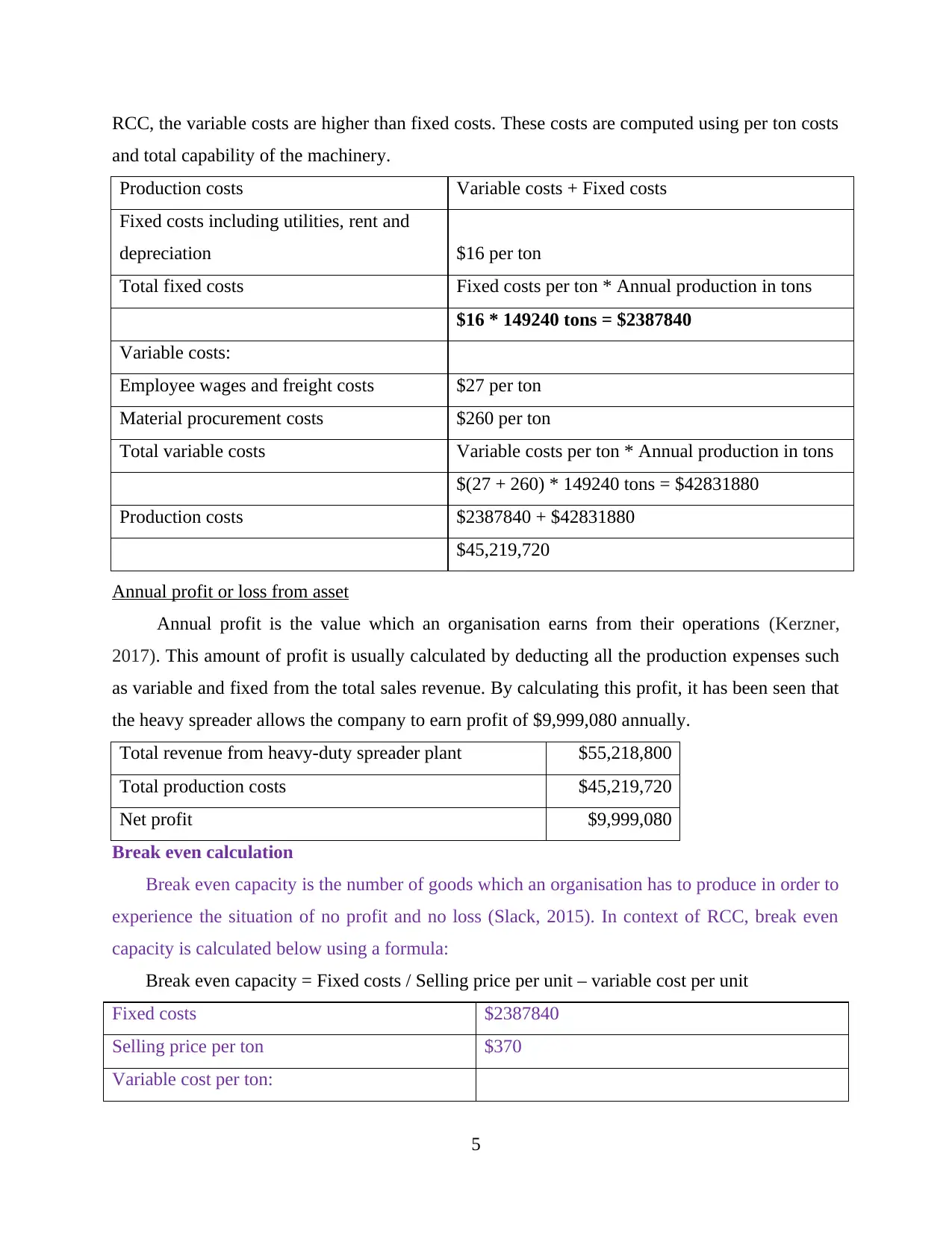
RCC, the variable costs are higher than fixed costs. These costs are computed using per ton costs
and total capability of the machinery.
Production costs Variable costs + Fixed costs
Fixed costs including utilities, rent and
depreciation $16 per ton
Total fixed costs Fixed costs per ton * Annual production in tons
$16 * 149240 tons = $2387840
Variable costs:
Employee wages and freight costs $27 per ton
Material procurement costs $260 per ton
Total variable costs Variable costs per ton * Annual production in tons
$(27 + 260) * 149240 tons = $42831880
Production costs $2387840 + $42831880
$45,219,720
Annual profit or loss from asset
Annual profit is the value which an organisation earns from their operations (Kerzner,
2017). This amount of profit is usually calculated by deducting all the production expenses such
as variable and fixed from the total sales revenue. By calculating this profit, it has been seen that
the heavy spreader allows the company to earn profit of $9,999,080 annually.
Total revenue from heavy-duty spreader plant $55,218,800
Total production costs $45,219,720
Net profit $9,999,080
Break even calculation
Break even capacity is the number of goods which an organisation has to produce in order to
experience the situation of no profit and no loss (Slack, 2015). In context of RCC, break even
capacity is calculated below using a formula:
Break even capacity = Fixed costs / Selling price per unit – variable cost per unit
Fixed costs $2387840
Selling price per ton $370
Variable cost per ton:
5
and total capability of the machinery.
Production costs Variable costs + Fixed costs
Fixed costs including utilities, rent and
depreciation $16 per ton
Total fixed costs Fixed costs per ton * Annual production in tons
$16 * 149240 tons = $2387840
Variable costs:
Employee wages and freight costs $27 per ton
Material procurement costs $260 per ton
Total variable costs Variable costs per ton * Annual production in tons
$(27 + 260) * 149240 tons = $42831880
Production costs $2387840 + $42831880
$45,219,720
Annual profit or loss from asset
Annual profit is the value which an organisation earns from their operations (Kerzner,
2017). This amount of profit is usually calculated by deducting all the production expenses such
as variable and fixed from the total sales revenue. By calculating this profit, it has been seen that
the heavy spreader allows the company to earn profit of $9,999,080 annually.
Total revenue from heavy-duty spreader plant $55,218,800
Total production costs $45,219,720
Net profit $9,999,080
Break even calculation
Break even capacity is the number of goods which an organisation has to produce in order to
experience the situation of no profit and no loss (Slack, 2015). In context of RCC, break even
capacity is calculated below using a formula:
Break even capacity = Fixed costs / Selling price per unit – variable cost per unit
Fixed costs $2387840
Selling price per ton $370
Variable cost per ton:
5

Employee wages and freight costs $27 per ton
Material procurement costs $260 per ton
Total variable cost per ton $287 per ton
Selling price per unit – variable cost per unit $370 - $287 = $83 per ton
Break even capacity $2387840 / $83
Break even capacity $28769.15 per ton
PART B - QUALITATIVE ANALYSIS
Identification of the different managerial challenges
Recycling Centre Corporation is an organisation which is currently facing various issues
due to their operational inefficiencies. It is important to identify, analyse and manage the
challenges which this company is facing so that effective strategies can be developed to
overcome those issues. All the major issues or challenges faced by this company are analysed
below:
Operations capacity management:
Operational capacity management is the procedure of managing the operating capacity of
the machineries and plants of an organisation (Heagney, 2016). From the quantitative analysis of
this company, it has been seen that the major machinery of this company is a heavy duty
spreader which has the capacity of 70 tons per hour. This capacity has the power to spread two
cars in a matter of just one minute. Having a heavy duty plant, this company is not able to utilise
its maximum capacity due to various reasons. These reasons include, as per the government
regulations, the machinery is only allowed to operate 55 hours in a week which reduces the
capacity of this machinery. This capacity is further decreased due to the waiting time. This
waiting time results in 11 hours a week which makes operating hours as 44 hours in a week.
These waiting hours are caused by material deficiencies. Apart from this, another three hours per
week are wasted against the break downs and mechanical failures; this results in operating hours
of the machinery to be 41 hours only. All these external and internal factors are the causes
behind the operational capacity reduction of heavy duty machinery and RCC.
Apart from this machinery, there are other machineries possessed by RCC as well which
are also not used at their maximum productivity due to above mentioned internal and external
6
Material procurement costs $260 per ton
Total variable cost per ton $287 per ton
Selling price per unit – variable cost per unit $370 - $287 = $83 per ton
Break even capacity $2387840 / $83
Break even capacity $28769.15 per ton
PART B - QUALITATIVE ANALYSIS
Identification of the different managerial challenges
Recycling Centre Corporation is an organisation which is currently facing various issues
due to their operational inefficiencies. It is important to identify, analyse and manage the
challenges which this company is facing so that effective strategies can be developed to
overcome those issues. All the major issues or challenges faced by this company are analysed
below:
Operations capacity management:
Operational capacity management is the procedure of managing the operating capacity of
the machineries and plants of an organisation (Heagney, 2016). From the quantitative analysis of
this company, it has been seen that the major machinery of this company is a heavy duty
spreader which has the capacity of 70 tons per hour. This capacity has the power to spread two
cars in a matter of just one minute. Having a heavy duty plant, this company is not able to utilise
its maximum capacity due to various reasons. These reasons include, as per the government
regulations, the machinery is only allowed to operate 55 hours in a week which reduces the
capacity of this machinery. This capacity is further decreased due to the waiting time. This
waiting time results in 11 hours a week which makes operating hours as 44 hours in a week.
These waiting hours are caused by material deficiencies. Apart from this, another three hours per
week are wasted against the break downs and mechanical failures; this results in operating hours
of the machinery to be 41 hours only. All these external and internal factors are the causes
behind the operational capacity reduction of heavy duty machinery and RCC.
Apart from this machinery, there are other machineries possessed by RCC as well which
are also not used at their maximum productivity due to above mentioned internal and external
6
⊘ This is a preview!⊘
Do you want full access?
Subscribe today to unlock all pages.

Trusted by 1+ million students worldwide
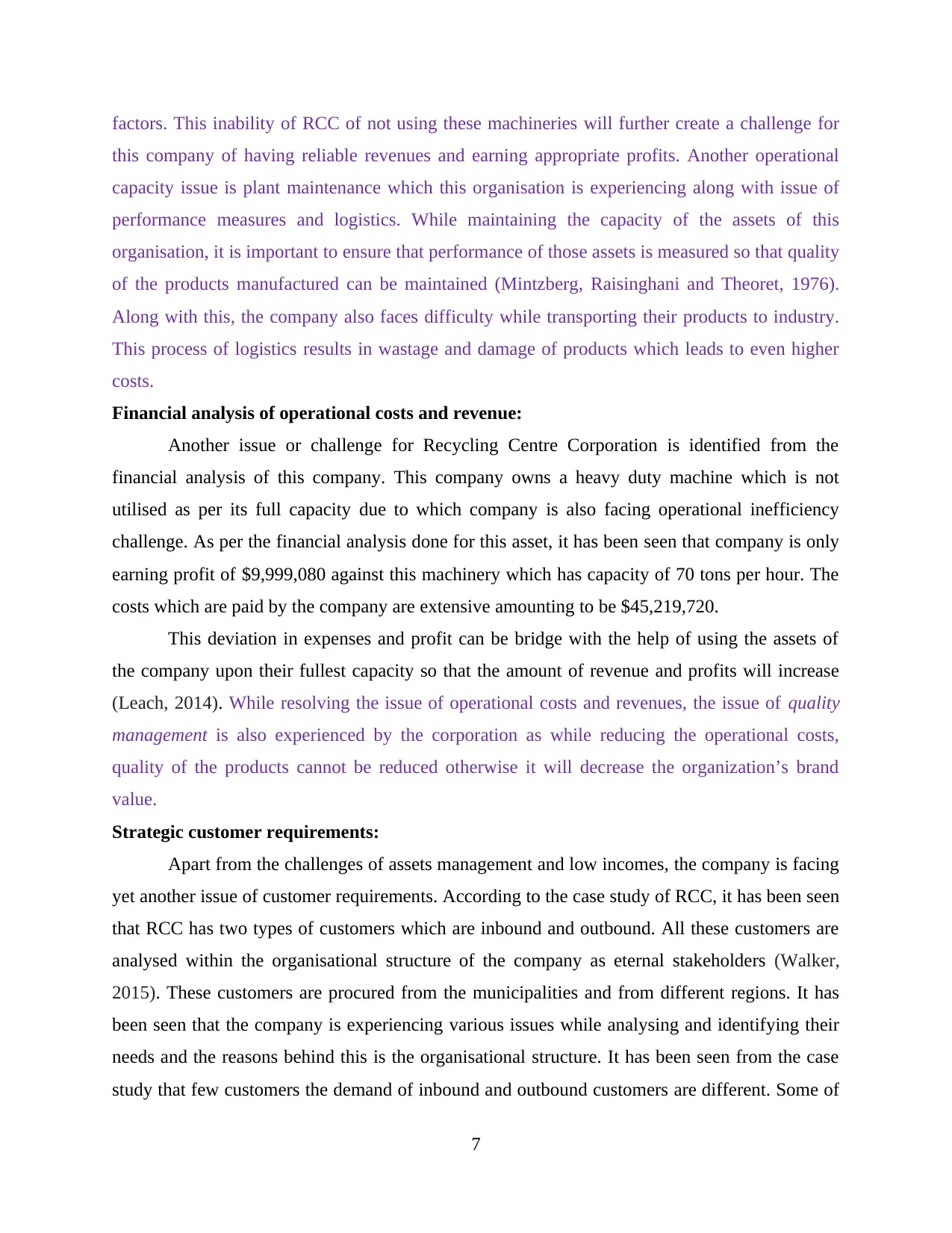
factors. This inability of RCC of not using these machineries will further create a challenge for
this company of having reliable revenues and earning appropriate profits. Another operational
capacity issue is plant maintenance which this organisation is experiencing along with issue of
performance measures and logistics. While maintaining the capacity of the assets of this
organisation, it is important to ensure that performance of those assets is measured so that quality
of the products manufactured can be maintained (Mintzberg, Raisinghani and Theoret, 1976).
Along with this, the company also faces difficulty while transporting their products to industry.
This process of logistics results in wastage and damage of products which leads to even higher
costs.
Financial analysis of operational costs and revenue:
Another issue or challenge for Recycling Centre Corporation is identified from the
financial analysis of this company. This company owns a heavy duty machine which is not
utilised as per its full capacity due to which company is also facing operational inefficiency
challenge. As per the financial analysis done for this asset, it has been seen that company is only
earning profit of $9,999,080 against this machinery which has capacity of 70 tons per hour. The
costs which are paid by the company are extensive amounting to be $45,219,720.
This deviation in expenses and profit can be bridge with the help of using the assets of
the company upon their fullest capacity so that the amount of revenue and profits will increase
(Leach, 2014). While resolving the issue of operational costs and revenues, the issue of quality
management is also experienced by the corporation as while reducing the operational costs,
quality of the products cannot be reduced otherwise it will decrease the organization’s brand
value.
Strategic customer requirements:
Apart from the challenges of assets management and low incomes, the company is facing
yet another issue of customer requirements. According to the case study of RCC, it has been seen
that RCC has two types of customers which are inbound and outbound. All these customers are
analysed within the organisational structure of the company as eternal stakeholders (Walker,
2015). These customers are procured from the municipalities and from different regions. It has
been seen that the company is experiencing various issues while analysing and identifying their
needs and the reasons behind this is the organisational structure. It has been seen from the case
study that few customers the demand of inbound and outbound customers are different. Some of
7
this company of having reliable revenues and earning appropriate profits. Another operational
capacity issue is plant maintenance which this organisation is experiencing along with issue of
performance measures and logistics. While maintaining the capacity of the assets of this
organisation, it is important to ensure that performance of those assets is measured so that quality
of the products manufactured can be maintained (Mintzberg, Raisinghani and Theoret, 1976).
Along with this, the company also faces difficulty while transporting their products to industry.
This process of logistics results in wastage and damage of products which leads to even higher
costs.
Financial analysis of operational costs and revenue:
Another issue or challenge for Recycling Centre Corporation is identified from the
financial analysis of this company. This company owns a heavy duty machine which is not
utilised as per its full capacity due to which company is also facing operational inefficiency
challenge. As per the financial analysis done for this asset, it has been seen that company is only
earning profit of $9,999,080 against this machinery which has capacity of 70 tons per hour. The
costs which are paid by the company are extensive amounting to be $45,219,720.
This deviation in expenses and profit can be bridge with the help of using the assets of
the company upon their fullest capacity so that the amount of revenue and profits will increase
(Leach, 2014). While resolving the issue of operational costs and revenues, the issue of quality
management is also experienced by the corporation as while reducing the operational costs,
quality of the products cannot be reduced otherwise it will decrease the organization’s brand
value.
Strategic customer requirements:
Apart from the challenges of assets management and low incomes, the company is facing
yet another issue of customer requirements. According to the case study of RCC, it has been seen
that RCC has two types of customers which are inbound and outbound. All these customers are
analysed within the organisational structure of the company as eternal stakeholders (Walker,
2015). These customers are procured from the municipalities and from different regions. It has
been seen that the company is experiencing various issues while analysing and identifying their
needs and the reasons behind this is the organisational structure. It has been seen from the case
study that few customers the demand of inbound and outbound customers are different. Some of
7
Paraphrase This Document
Need a fresh take? Get an instant paraphrase of this document with our AI Paraphraser
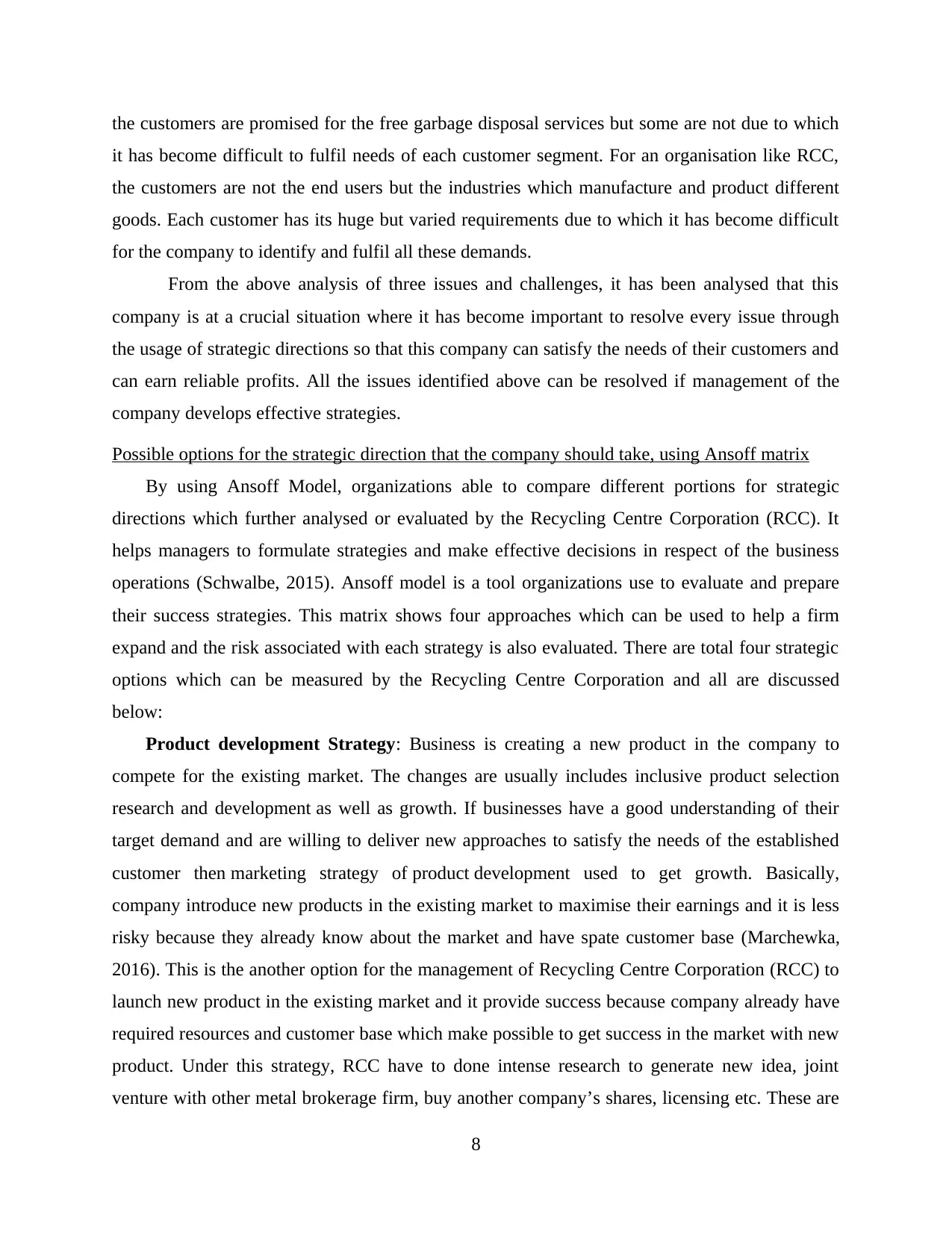
the customers are promised for the free garbage disposal services but some are not due to which
it has become difficult to fulfil needs of each customer segment. For an organisation like RCC,
the customers are not the end users but the industries which manufacture and product different
goods. Each customer has its huge but varied requirements due to which it has become difficult
for the company to identify and fulfil all these demands.
From the above analysis of three issues and challenges, it has been analysed that this
company is at a crucial situation where it has become important to resolve every issue through
the usage of strategic directions so that this company can satisfy the needs of their customers and
can earn reliable profits. All the issues identified above can be resolved if management of the
company develops effective strategies.
Possible options for the strategic direction that the company should take, using Ansoff matrix
By using Ansoff Model, organizations able to compare different portions for strategic
directions which further analysed or evaluated by the Recycling Centre Corporation (RCC). It
helps managers to formulate strategies and make effective decisions in respect of the business
operations (Schwalbe, 2015). Ansoff model is a tool organizations use to evaluate and prepare
their success strategies. This matrix shows four approaches which can be used to help a firm
expand and the risk associated with each strategy is also evaluated. There are total four strategic
options which can be measured by the Recycling Centre Corporation and all are discussed
below:
Product development Strategy: Business is creating a new product in the company to
compete for the existing market. The changes are usually includes inclusive product selection
research and development as well as growth. If businesses have a good understanding of their
target demand and are willing to deliver new approaches to satisfy the needs of the established
customer then marketing strategy of product development used to get growth. Basically,
company introduce new products in the existing market to maximise their earnings and it is less
risky because they already know about the market and have spate customer base (Marchewka,
2016). This is the another option for the management of Recycling Centre Corporation (RCC) to
launch new product in the existing market and it provide success because company already have
required resources and customer base which make possible to get success in the market with new
product. Under this strategy, RCC have to done intense research to generate new idea, joint
venture with other metal brokerage firm, buy another company’s shares, licensing etc. These are
8
it has become difficult to fulfil needs of each customer segment. For an organisation like RCC,
the customers are not the end users but the industries which manufacture and product different
goods. Each customer has its huge but varied requirements due to which it has become difficult
for the company to identify and fulfil all these demands.
From the above analysis of three issues and challenges, it has been analysed that this
company is at a crucial situation where it has become important to resolve every issue through
the usage of strategic directions so that this company can satisfy the needs of their customers and
can earn reliable profits. All the issues identified above can be resolved if management of the
company develops effective strategies.
Possible options for the strategic direction that the company should take, using Ansoff matrix
By using Ansoff Model, organizations able to compare different portions for strategic
directions which further analysed or evaluated by the Recycling Centre Corporation (RCC). It
helps managers to formulate strategies and make effective decisions in respect of the business
operations (Schwalbe, 2015). Ansoff model is a tool organizations use to evaluate and prepare
their success strategies. This matrix shows four approaches which can be used to help a firm
expand and the risk associated with each strategy is also evaluated. There are total four strategic
options which can be measured by the Recycling Centre Corporation and all are discussed
below:
Product development Strategy: Business is creating a new product in the company to
compete for the existing market. The changes are usually includes inclusive product selection
research and development as well as growth. If businesses have a good understanding of their
target demand and are willing to deliver new approaches to satisfy the needs of the established
customer then marketing strategy of product development used to get growth. Basically,
company introduce new products in the existing market to maximise their earnings and it is less
risky because they already know about the market and have spate customer base (Marchewka,
2016). This is the another option for the management of Recycling Centre Corporation (RCC) to
launch new product in the existing market and it provide success because company already have
required resources and customer base which make possible to get success in the market with new
product. Under this strategy, RCC have to done intense research to generate new idea, joint
venture with other metal brokerage firm, buy another company’s shares, licensing etc. These are
8
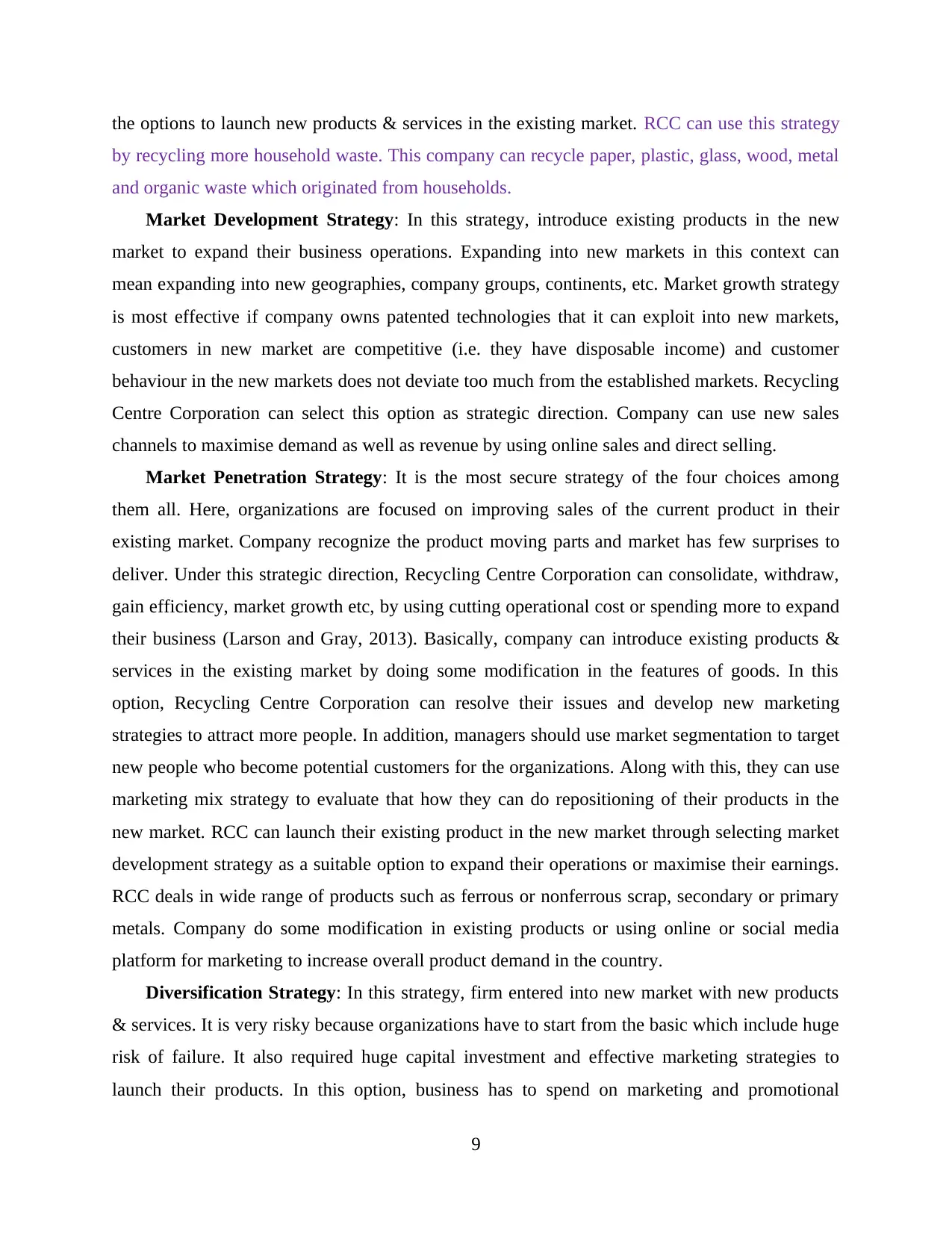
the options to launch new products & services in the existing market. RCC can use this strategy
by recycling more household waste. This company can recycle paper, plastic, glass, wood, metal
and organic waste which originated from households.
Market Development Strategy: In this strategy, introduce existing products in the new
market to expand their business operations. Expanding into new markets in this context can
mean expanding into new geographies, company groups, continents, etc. Market growth strategy
is most effective if company owns patented technologies that it can exploit into new markets,
customers in new market are competitive (i.e. they have disposable income) and customer
behaviour in the new markets does not deviate too much from the established markets. Recycling
Centre Corporation can select this option as strategic direction. Company can use new sales
channels to maximise demand as well as revenue by using online sales and direct selling.
Market Penetration Strategy: It is the most secure strategy of the four choices among
them all. Here, organizations are focused on improving sales of the current product in their
existing market. Company recognize the product moving parts and market has few surprises to
deliver. Under this strategic direction, Recycling Centre Corporation can consolidate, withdraw,
gain efficiency, market growth etc, by using cutting operational cost or spending more to expand
their business (Larson and Gray, 2013). Basically, company can introduce existing products &
services in the existing market by doing some modification in the features of goods. In this
option, Recycling Centre Corporation can resolve their issues and develop new marketing
strategies to attract more people. In addition, managers should use market segmentation to target
new people who become potential customers for the organizations. Along with this, they can use
marketing mix strategy to evaluate that how they can do repositioning of their products in the
new market. RCC can launch their existing product in the new market through selecting market
development strategy as a suitable option to expand their operations or maximise their earnings.
RCC deals in wide range of products such as ferrous or nonferrous scrap, secondary or primary
metals. Company do some modification in existing products or using online or social media
platform for marketing to increase overall product demand in the country.
Diversification Strategy: In this strategy, firm entered into new market with new products
& services. It is very risky because organizations have to start from the basic which include huge
risk of failure. It also required huge capital investment and effective marketing strategies to
launch their products. In this option, business has to spend on marketing and promotional
9
by recycling more household waste. This company can recycle paper, plastic, glass, wood, metal
and organic waste which originated from households.
Market Development Strategy: In this strategy, introduce existing products in the new
market to expand their business operations. Expanding into new markets in this context can
mean expanding into new geographies, company groups, continents, etc. Market growth strategy
is most effective if company owns patented technologies that it can exploit into new markets,
customers in new market are competitive (i.e. they have disposable income) and customer
behaviour in the new markets does not deviate too much from the established markets. Recycling
Centre Corporation can select this option as strategic direction. Company can use new sales
channels to maximise demand as well as revenue by using online sales and direct selling.
Market Penetration Strategy: It is the most secure strategy of the four choices among
them all. Here, organizations are focused on improving sales of the current product in their
existing market. Company recognize the product moving parts and market has few surprises to
deliver. Under this strategic direction, Recycling Centre Corporation can consolidate, withdraw,
gain efficiency, market growth etc, by using cutting operational cost or spending more to expand
their business (Larson and Gray, 2013). Basically, company can introduce existing products &
services in the existing market by doing some modification in the features of goods. In this
option, Recycling Centre Corporation can resolve their issues and develop new marketing
strategies to attract more people. In addition, managers should use market segmentation to target
new people who become potential customers for the organizations. Along with this, they can use
marketing mix strategy to evaluate that how they can do repositioning of their products in the
new market. RCC can launch their existing product in the new market through selecting market
development strategy as a suitable option to expand their operations or maximise their earnings.
RCC deals in wide range of products such as ferrous or nonferrous scrap, secondary or primary
metals. Company do some modification in existing products or using online or social media
platform for marketing to increase overall product demand in the country.
Diversification Strategy: In this strategy, firm entered into new market with new products
& services. It is very risky because organizations have to start from the basic which include huge
risk of failure. It also required huge capital investment and effective marketing strategies to
launch their products. In this option, business has to spend on marketing and promotional
9
⊘ This is a preview!⊘
Do you want full access?
Subscribe today to unlock all pages.

Trusted by 1+ million students worldwide
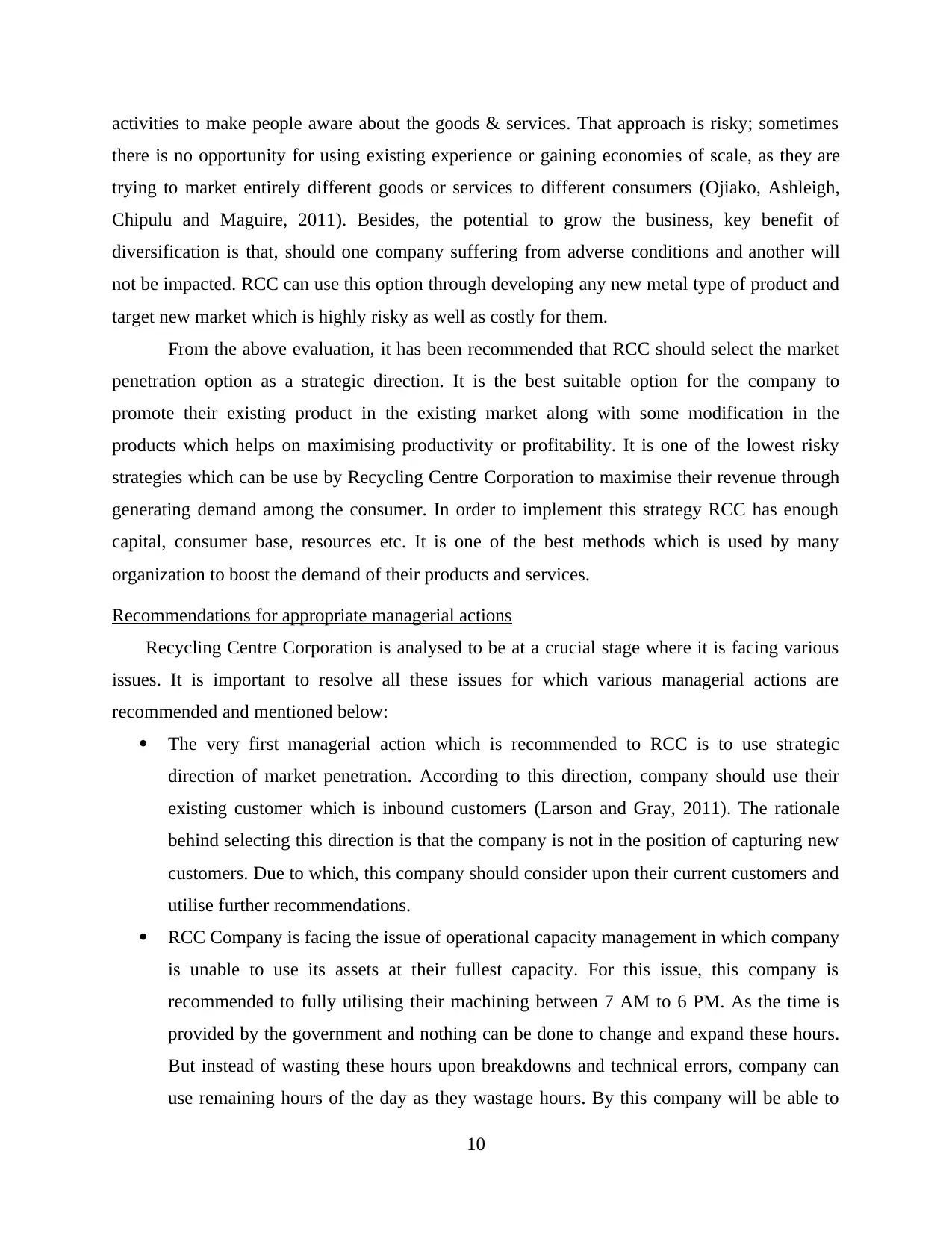
activities to make people aware about the goods & services. That approach is risky; sometimes
there is no opportunity for using existing experience or gaining economies of scale, as they are
trying to market entirely different goods or services to different consumers (Ojiako, Ashleigh,
Chipulu and Maguire, 2011). Besides, the potential to grow the business, key benefit of
diversification is that, should one company suffering from adverse conditions and another will
not be impacted. RCC can use this option through developing any new metal type of product and
target new market which is highly risky as well as costly for them.
From the above evaluation, it has been recommended that RCC should select the market
penetration option as a strategic direction. It is the best suitable option for the company to
promote their existing product in the existing market along with some modification in the
products which helps on maximising productivity or profitability. It is one of the lowest risky
strategies which can be use by Recycling Centre Corporation to maximise their revenue through
generating demand among the consumer. In order to implement this strategy RCC has enough
capital, consumer base, resources etc. It is one of the best methods which is used by many
organization to boost the demand of their products and services.
Recommendations for appropriate managerial actions
Recycling Centre Corporation is analysed to be at a crucial stage where it is facing various
issues. It is important to resolve all these issues for which various managerial actions are
recommended and mentioned below:
The very first managerial action which is recommended to RCC is to use strategic
direction of market penetration. According to this direction, company should use their
existing customer which is inbound customers (Larson and Gray, 2011). The rationale
behind selecting this direction is that the company is not in the position of capturing new
customers. Due to which, this company should consider upon their current customers and
utilise further recommendations.
RCC Company is facing the issue of operational capacity management in which company
is unable to use its assets at their fullest capacity. For this issue, this company is
recommended to fully utilising their machining between 7 AM to 6 PM. As the time is
provided by the government and nothing can be done to change and expand these hours.
But instead of wasting these hours upon breakdowns and technical errors, company can
use remaining hours of the day as they wastage hours. By this company will be able to
10
there is no opportunity for using existing experience or gaining economies of scale, as they are
trying to market entirely different goods or services to different consumers (Ojiako, Ashleigh,
Chipulu and Maguire, 2011). Besides, the potential to grow the business, key benefit of
diversification is that, should one company suffering from adverse conditions and another will
not be impacted. RCC can use this option through developing any new metal type of product and
target new market which is highly risky as well as costly for them.
From the above evaluation, it has been recommended that RCC should select the market
penetration option as a strategic direction. It is the best suitable option for the company to
promote their existing product in the existing market along with some modification in the
products which helps on maximising productivity or profitability. It is one of the lowest risky
strategies which can be use by Recycling Centre Corporation to maximise their revenue through
generating demand among the consumer. In order to implement this strategy RCC has enough
capital, consumer base, resources etc. It is one of the best methods which is used by many
organization to boost the demand of their products and services.
Recommendations for appropriate managerial actions
Recycling Centre Corporation is analysed to be at a crucial stage where it is facing various
issues. It is important to resolve all these issues for which various managerial actions are
recommended and mentioned below:
The very first managerial action which is recommended to RCC is to use strategic
direction of market penetration. According to this direction, company should use their
existing customer which is inbound customers (Larson and Gray, 2011). The rationale
behind selecting this direction is that the company is not in the position of capturing new
customers. Due to which, this company should consider upon their current customers and
utilise further recommendations.
RCC Company is facing the issue of operational capacity management in which company
is unable to use its assets at their fullest capacity. For this issue, this company is
recommended to fully utilising their machining between 7 AM to 6 PM. As the time is
provided by the government and nothing can be done to change and expand these hours.
But instead of wasting these hours upon breakdowns and technical errors, company can
use remaining hours of the day as they wastage hours. By this company will be able to
10
Paraphrase This Document
Need a fresh take? Get an instant paraphrase of this document with our AI Paraphraser
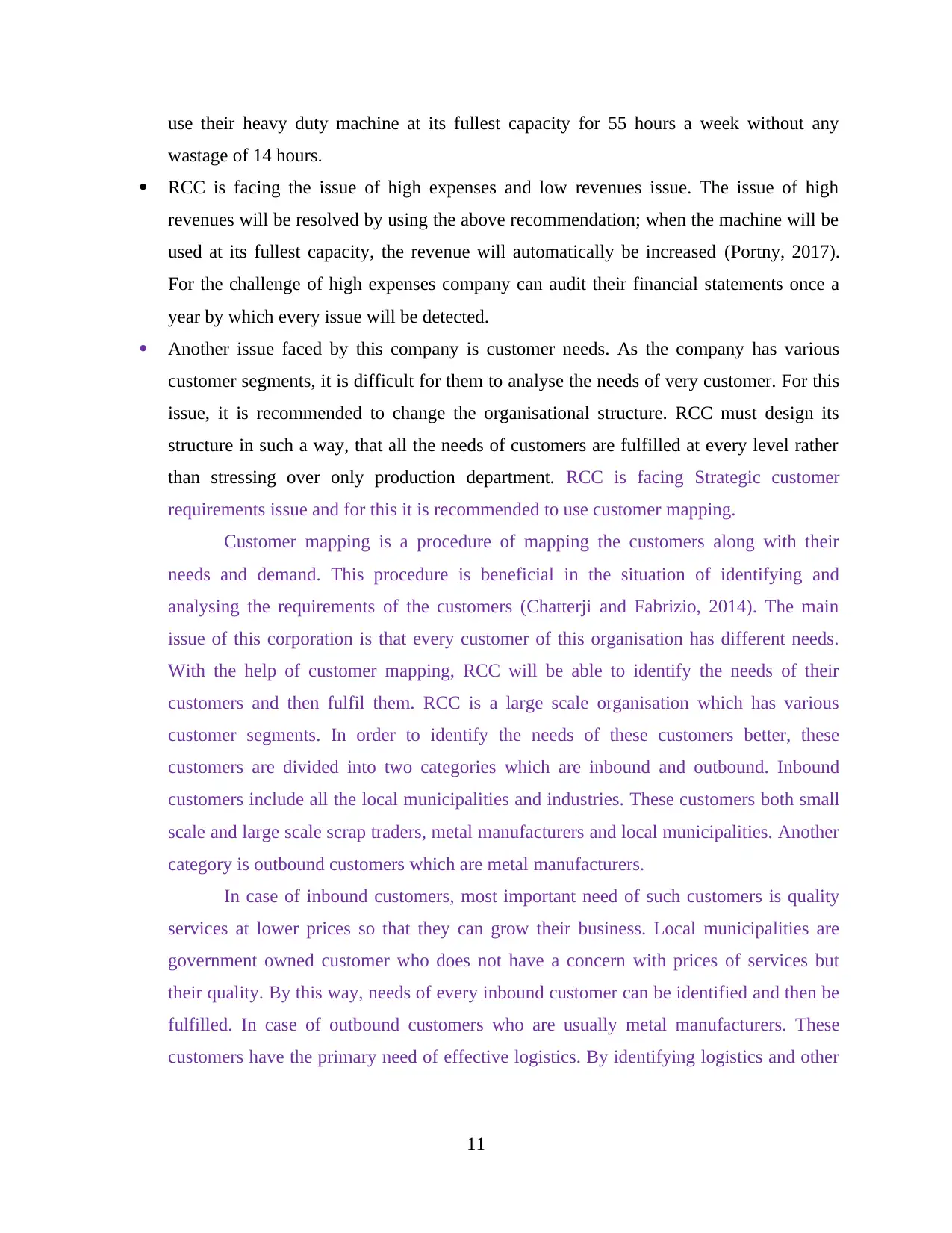
use their heavy duty machine at its fullest capacity for 55 hours a week without any
wastage of 14 hours.
RCC is facing the issue of high expenses and low revenues issue. The issue of high
revenues will be resolved by using the above recommendation; when the machine will be
used at its fullest capacity, the revenue will automatically be increased (Portny, 2017).
For the challenge of high expenses company can audit their financial statements once a
year by which every issue will be detected.
Another issue faced by this company is customer needs. As the company has various
customer segments, it is difficult for them to analyse the needs of very customer. For this
issue, it is recommended to change the organisational structure. RCC must design its
structure in such a way, that all the needs of customers are fulfilled at every level rather
than stressing over only production department. RCC is facing Strategic customer
requirements issue and for this it is recommended to use customer mapping.
Customer mapping is a procedure of mapping the customers along with their
needs and demand. This procedure is beneficial in the situation of identifying and
analysing the requirements of the customers (Chatterji and Fabrizio, 2014). The main
issue of this corporation is that every customer of this organisation has different needs.
With the help of customer mapping, RCC will be able to identify the needs of their
customers and then fulfil them. RCC is a large scale organisation which has various
customer segments. In order to identify the needs of these customers better, these
customers are divided into two categories which are inbound and outbound. Inbound
customers include all the local municipalities and industries. These customers both small
scale and large scale scrap traders, metal manufacturers and local municipalities. Another
category is outbound customers which are metal manufacturers.
In case of inbound customers, most important need of such customers is quality
services at lower prices so that they can grow their business. Local municipalities are
government owned customer who does not have a concern with prices of services but
their quality. By this way, needs of every inbound customer can be identified and then be
fulfilled. In case of outbound customers who are usually metal manufacturers. These
customers have the primary need of effective logistics. By identifying logistics and other
11
wastage of 14 hours.
RCC is facing the issue of high expenses and low revenues issue. The issue of high
revenues will be resolved by using the above recommendation; when the machine will be
used at its fullest capacity, the revenue will automatically be increased (Portny, 2017).
For the challenge of high expenses company can audit their financial statements once a
year by which every issue will be detected.
Another issue faced by this company is customer needs. As the company has various
customer segments, it is difficult for them to analyse the needs of very customer. For this
issue, it is recommended to change the organisational structure. RCC must design its
structure in such a way, that all the needs of customers are fulfilled at every level rather
than stressing over only production department. RCC is facing Strategic customer
requirements issue and for this it is recommended to use customer mapping.
Customer mapping is a procedure of mapping the customers along with their
needs and demand. This procedure is beneficial in the situation of identifying and
analysing the requirements of the customers (Chatterji and Fabrizio, 2014). The main
issue of this corporation is that every customer of this organisation has different needs.
With the help of customer mapping, RCC will be able to identify the needs of their
customers and then fulfil them. RCC is a large scale organisation which has various
customer segments. In order to identify the needs of these customers better, these
customers are divided into two categories which are inbound and outbound. Inbound
customers include all the local municipalities and industries. These customers both small
scale and large scale scrap traders, metal manufacturers and local municipalities. Another
category is outbound customers which are metal manufacturers.
In case of inbound customers, most important need of such customers is quality
services at lower prices so that they can grow their business. Local municipalities are
government owned customer who does not have a concern with prices of services but
their quality. By this way, needs of every inbound customer can be identified and then be
fulfilled. In case of outbound customers who are usually metal manufacturers. These
customers have the primary need of effective logistics. By identifying logistics and other
11
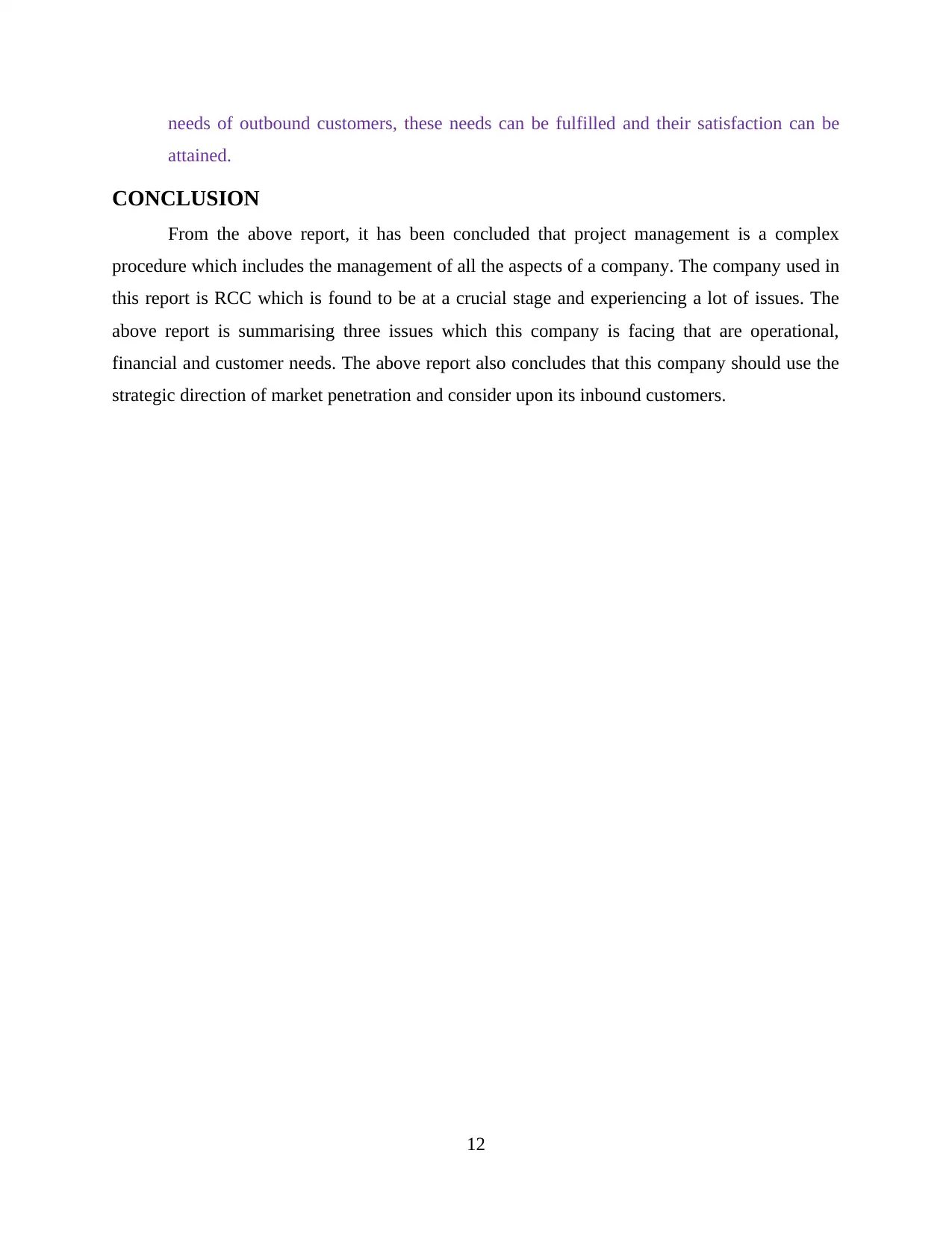
needs of outbound customers, these needs can be fulfilled and their satisfaction can be
attained.
CONCLUSION
From the above report, it has been concluded that project management is a complex
procedure which includes the management of all the aspects of a company. The company used in
this report is RCC which is found to be at a crucial stage and experiencing a lot of issues. The
above report is summarising three issues which this company is facing that are operational,
financial and customer needs. The above report also concludes that this company should use the
strategic direction of market penetration and consider upon its inbound customers.
12
attained.
CONCLUSION
From the above report, it has been concluded that project management is a complex
procedure which includes the management of all the aspects of a company. The company used in
this report is RCC which is found to be at a crucial stage and experiencing a lot of issues. The
above report is summarising three issues which this company is facing that are operational,
financial and customer needs. The above report also concludes that this company should use the
strategic direction of market penetration and consider upon its inbound customers.
12
⊘ This is a preview!⊘
Do you want full access?
Subscribe today to unlock all pages.

Trusted by 1+ million students worldwide
1 out of 13
Related Documents
Your All-in-One AI-Powered Toolkit for Academic Success.
+13062052269
info@desklib.com
Available 24*7 on WhatsApp / Email
![[object Object]](/_next/static/media/star-bottom.7253800d.svg)
Unlock your academic potential
Copyright © 2020–2025 A2Z Services. All Rights Reserved. Developed and managed by ZUCOL.





